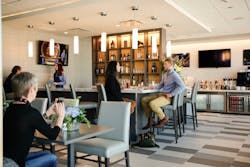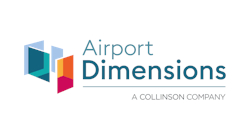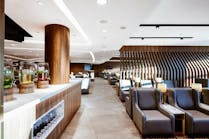Flight Delayed and Not a Care in the World: How Shared-use Lounges are changing the Way Consumers Interact with Airlines and Airports
With global retail spending at airports expected to reach $58.4 billion by 2022, up from $40 billion in 2017, it’s obvious that both airports and airline operators want to utilize the available space to its fullest. Numerous airports are making room for additional retail outlets and airlines are more than happy to be in the company of this growing trend. Premium brands have quickly taken notice and have already begun their aggressive push to stake a claim. This was particularly apparent after cosmetics powerhouse Estée Lauder announced that in 2018 it had generated more revenue at airports globally than at U.S. department stores. Some retail companies are also assembling pop-up experiences that range from food and fashion to wellness and gadgets – all with the goal of capitalizing on passengers’ time.
Not all travelers want to indulge exclusively in retail experiences during their airport visits, however. Demand for airport lounge space continues to increase due to the rise of high-end lounge offerings, such as those offered by Priority Pass, a membership available for purchase and through some premium credit cards. As more travelers seek airport lounge access, airports around the world are realizing that travelers’ increasing demands must be met if they want to be the first choice for fliers.
Airlines are also beginning to re-examine their passengers’ experiences within the terminal. They are investing in premium, exclusive lounges that are designed for frequent fliers. Better still, these lounges encourage others to fly more often, knowing that there are added benefits waiting to be accessed.
With little room to maneuver during the flight, airside offerings are an opportunity for an airline to differentiate its brand and ensure travelers’ demands for comfort and luxury are met before take-off. Airline alliances – such as STAR, SkyTeam and Oneworld – enable multiple carriers to invest in lounge spaces.
Other airlines are finding alternative ways to ensure that lounges form an important part of their pre-flight experience no matter where they operate in the world.
Use existing shared-use operators
Airlines that only have a few flights departing from an airport on a daily basis typically shouldn’t invest in their own lounge space. These airlines might instead choose to work with a lounge operator to develop a shared-use lounge space that is available to the airline’s passengers, as well as other airport travelers.
Every new, non-airline guest fosters additional revenue while simultaneously reducing both the costs for catering and management, as well as the periods of time when the lounge isn’t being used. As more individuals seek out spaces to enhance their overall travel experience, this model of investing in a shared-use lounge space continues to grow in popularity.
Establish partnerships with shared-use operators
If an airline has invested in a lounge space but discovers that it isn’t being used as often as it should be, the airline may choose a different strategy.
While still retaining ownership of the lease, the airline can partner with an operator, such as Airport Dimensions, to manage its lounge and broaden its appeal by marketing to additional travelers flying different airlines.
Airlines can then choose to offer exclusive use for their premium customers during the few select hours when those passengers are in the airport. With the remainder of the day open to those flying with other carriers, revenue will increase while operating costs decline.
Outsourcing operations
Alternatively, an airline can outsource the operation and management of its lounge to a third-party operator. The airline may similarly seek to have exclusive lounge access during certain hours, even while ceding ownership of a lounge to a separate operator. By granting access to new guests, such as Priority Pass members, when the airline’s travelers aren’t using the lounge, it will benefit all parties equally.
Airlines who do so will enjoy lower costs and attain higher satisfaction of existing customers. At the same time, they will be able to reach new, third-party customers by giving them access to a lounge that was previously unavailable.
There are a number of different shared-use options available for airports and airline operators, and that list is bound to grow as they continue to deliver a quality customer experience to all travelers. In order to ensure that these shared-use lounges run efficiently and are being utilized to their full potential, there needs to be a change in the way lounges are used and offered to travelers. Airports and airlines may even partner with lounge operators in order to differentiate their on-the-ground experience in innovative new ways. This could include concierge services to fulfill their curiosity or on-the-go food and drinks to satisfy their cravings.
A constant evolution
The airport is a space of constant evolution in which the passengers’ needs are met in new and exciting ways. From frequent fliers who can enjoy a growing number of benefits pre-flight to serving new customers who were once out of reach, the innovations of a shared-use lounge have already begun to leave their mark. Expect to see improvements in how lounges deliver brand value through sophisticated designs, unique experiences and customer service in the years to come.
Nancy Knipp is Senior Vice President at Airport Dimensions. Since joining in October 2013, the company has grown from five lounges in the U.S. to 23 independent shared-use lounges globally and developed partnerships with over 25 airline partners. In her role, Nancy oversees all aspects of the company’s strategic network growth, marketing and sales efforts and financial performance in the Americas.





